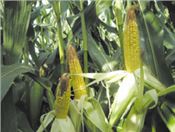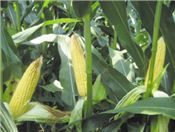|
“Tip-Back” And The 2016 Corn Crop
DR. EMERSON NAFZIGER
URBANA, ILL.
Although my post last week reflected the current optimism about yield prospects for the 2016 Illinois corn crop, there has been some recent discussion about unfilled ear tips and whether or not this might mean lower yields than the appearance of the crop leads us to believe.
Corn ears with kernels missing at the outer end of the ear are often said to have “tip-back.” The term is a little obscure, but the idea is that the end of the cob has been exposed by lack of kernels there, and that something happened to cause the ear to adjust its kernel number downward so it won’t have as many kernels to fill.
The missing kernels can be aborted kernels – ones that were fertilized but stopped developing – or can be kernel initials that weren’t fertilized due to problems with the pollination process. Low sugar levels in the plant before, during, and after pollination are often associated with such loss of kernels.
Because kernel number is closely related to yield, missing kernels on an ear suggest to many people that yield has been lost. Drought stress, loss of leaf area to hail or disease, or lack of nitrogen all result in stress that lowers photosynthesis and so decreases the sugar supply. So we associate low kernel numbers with stress. If different hybrids show different amounts of tip-back, this is taken as an indication of their tolerance to stress.
While low kernels numbers per acre and low yields do go together, it’s important in a year like this to consider the overall condition of the crop and to focus on how many kernels are present before worrying about how many kernels seem to be missing. We often see some amount of tip-back even in good years, and this may have no effect on yield if kernel numbers are still high.
As an example, under outstanding pollination conditions in 2014, we saw almost no tip-back; ears were filled out to the very end of the cob. There was much more tip-back in 2015, but kernel counts per acre and yields were as high in many areas in 2015 as in 2014. While we don’t think that having some tip-back is necessary to show that the ear had “extra” room in case it was needed it, it’s much more common to see some tip-back than to see none, and we don’t consider tip-back to be a problem if kernels numbers are high.
What matters for yield is the number of kernels per acre that fill, along with the ability of the crop to fill them completely. So 34,000 ears each with 16 rows of kernels and 35 kernels per row should produce yields in the vicinity of 220 bushels, even if most cobs have “room” on the end for another 50 or 100 kernels. At high yield levels when all of the nutrients the plant produces go to fill kernels, having more kernels may mean that kernels stay smaller, and yield may not change much.
In looking at some of our corn on South Farm on August 3, I saw more variability in kernel number and some smaller ears than I expected. In one field planted at about 36,000 seeds on April 20, plants were about 10 ft. tall but stalks were small in diameter and ear placement was high and somewhat variable. Figure 1 shows some ears in this field. This crop came up well and has had the dark green leaves and uniform appearance that most fields in the area have shown since emergence. But there are only about 375 kernels per ear on average, and if kernels fill to normal weight, yield will be around 160 bushels per acre. Ears show a lot of tip-back, and having silks still attached suggest that most of this resulted from failure of pollination. Kernels were in the late milk stage which is in line with planting date, but otherwise the crop has the appearance of corn that was planted late.
In another field with similar soil planted at the same time with slightly lower population, plants were not quite as tall, stalks were larger in diameter, and ears were more uniform in both placement and size (Figure 2). These ears show a small amount of tip-back, but with an average of about 600 kernels per ear, this field should yield 225 bushels per acre or more.
There are no obvious reasons why similar fields planted at about the same time should have such different kernel numbers and yield potential. The hybrids are different, but the field with lower yield potential has a number of different hybrids and most seem to show some degree of the same problem.
Even when plants emerge well and looked uniform in size and canopy color during vegetative growth, variability in ear size and placement suggests that plant-to-plant competition began early and increased during vegetative growth, eventually showing up as non-uniform ear development and lower kernel numbers. We can only speculate about how this might have happened, and why fields differ as much as they do. With the exception of a couple of cool periods in May, temperatures in May and June were warm and there was a lot of sunshine. Rainfall both months was near normal, but the latter half of June was dry, which could have meant more underground competition.
It appears that the crop used a lot of resources to grow the plant, including roots as they grew deeper during dry weather in the weeks before pollination. Uniformly warm air and soil temperatures and rapid growth during that period might have meant some diversion of sugars away from ear growth and kernel set. It’s also possible that uptake of water was slightly lower in some soils due to texture or root growth and uptake, and that the crop in such soils experienced a little more stress.
Although we can’t do anything to change kernel numbers now, it is worthwhile to visit each field to note kernel number and other plant characteristics that can help explain what happened in different fields. While the Illinois corn crop condition overall remains good, some fields may have disappointing kernel numbers even on plants that continue to look very good. Note which hybrids show this, but given that this may be a one-time phenomenon, be cautious about discarding hybrids, especially those that have been top-yielding in the past. ∆
DR. EMERSON NAFZIGER: Research Education Center Coordinator, Professor, University of Illinois

Figure 1. Ears in corn planted at 36,000 per acre on April 20.

Ears in corn planted at 34,000 on April 22.
|
|